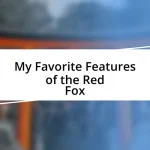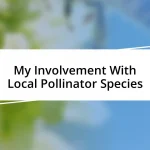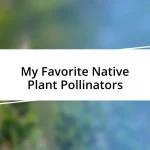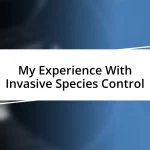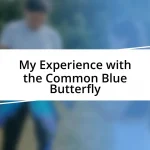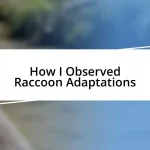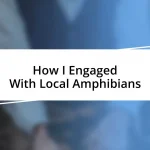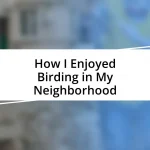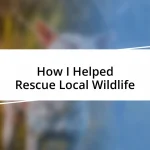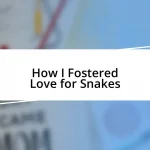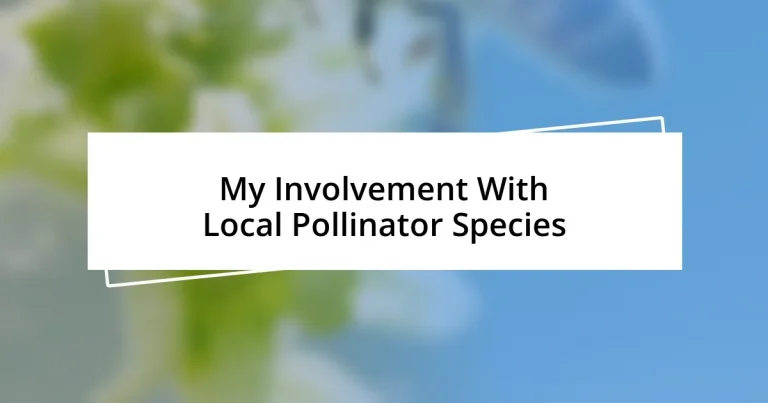Key takeaways:
- Local pollinators like bees, butterflies, and hummingbirds are essential for the reproduction of over 75% of flowering plants, impacting food production and ecosystem health.
- Creating pollinator-friendly habitats involves incorporating native plants, providing water sources, and eliminating pesticides to support biodiversity and balance in local ecosystems.
- Identifying and understanding the unique behaviors of local pollinators enhances appreciation for their roles in nature and encourages active support for their populations.
- Simple actions, such as planting diverse flowering plants and creating nesting sites, can significantly benefit local pollinator communities and contribute to environmental health.
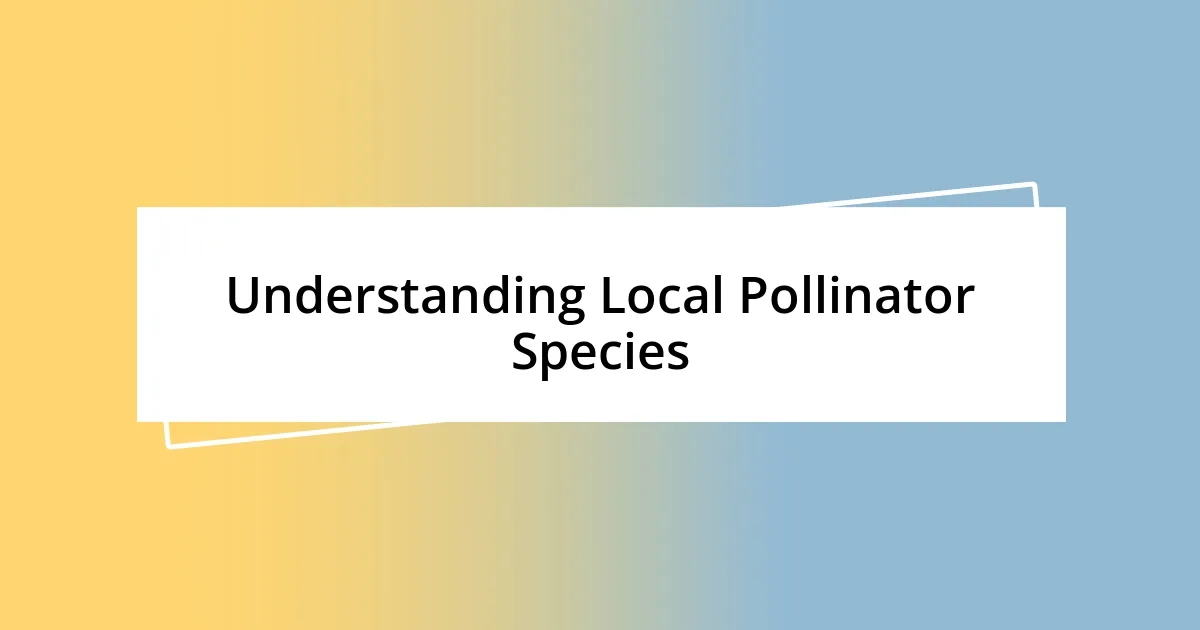
Understanding Local Pollinator Species
Understanding local pollinator species is like meeting fascinating new friends in your backyard. I remember the first time I noticed a honeybee busily working between my flower beds—it made me realize how crucial these little creatures are to our ecosystem. Have you ever paused to watch a bumblebee fluffing its wings as it moves from bloom to bloom, seemingly oblivious to the world outside its floral paradise?
It’s astonishing to think that over 75% of the world’s flowering plants, including many of our fruits and vegetables, rely on these pollinators for reproduction. Yet, I often wonder how many people know that simple actions—like planting native flowers—can make a huge difference in supporting these species. One summer, I transformed a patch of my garden into a vibrant space filled with diverse native plants, and it felt incredible when I saw the population of pollinators thrive.
Local pollinators, such as butterflies, bees, and hummingbirds, each play unique roles in maintaining our ecosystems. When I first learned about the specific needs of these species, from nesting sites to food sources, I felt empowered to create a more welcoming environment for them. Do you think your own garden can become a sanctuary for these important allies? By paying attention and actively nurturing their presence, we can all contribute to the health of our local pollinator communities.
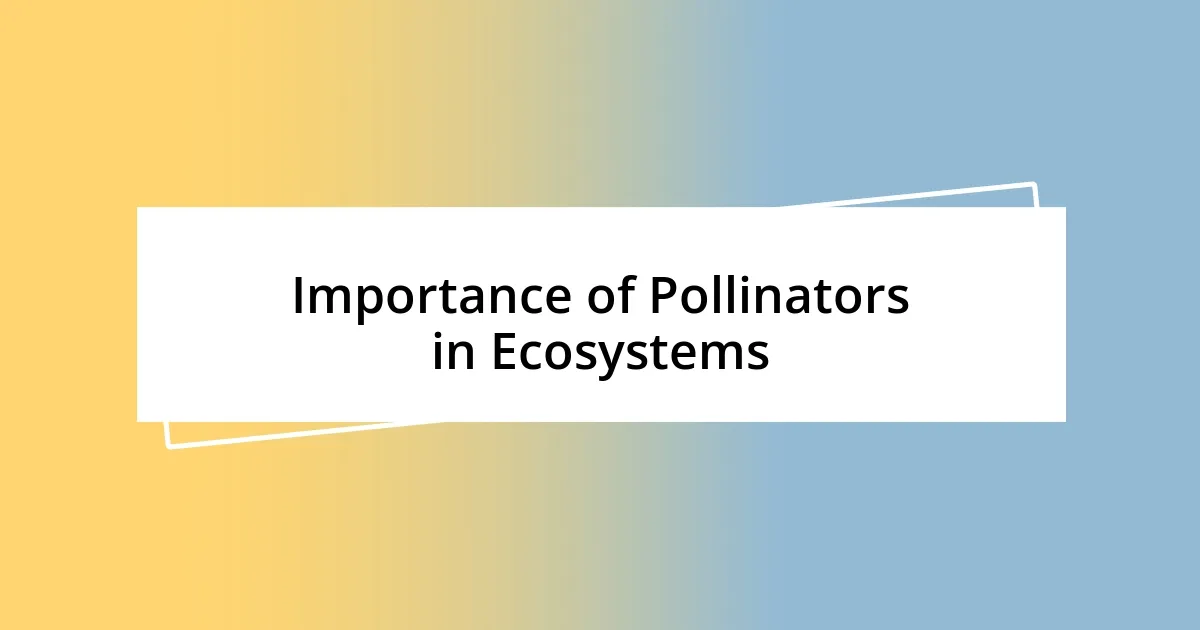
Importance of Pollinators in Ecosystems
Pollinators are the unsung heroes of our ecosystems, playing a vital role in plant reproduction and food production. I remember visiting a local farmer’s market and marveling at the variety of fruits and vegetables on display—each one a testament to the hard work of these small creatures. Without pollinators, many of these crops simply wouldn’t exist, which would significantly diminish our food supply and plant diversity.
When I started noticing how different flowers attracted different species, it dawned on me just how interconnected everything is in nature. A single bumblebee can visit hundreds of flowers in one day, and this not only helps produce seeds but fosters genetic diversity among plants. This diversity has a ripple effect throughout the ecosystem; a richer plant community can support a wider range of wildlife, leading to a more balanced natural environment. Remember that day in my garden when I planted a variety of blooming plants? Each one brought in new pollinators, creating a symphony of activity that added life to my little patch of earth.
The connection between pollinators and ecosystems extends far beyond just producing food. They also help maintain the balance of different plant species, which can influence local climates and provide habitats for other wildlife. One evening, while sipping tea on my porch, I watched the delicate dance of dragonflies above my blooming garden, and I realized my efforts to attract pollinators had transformed my space into a vibrant micro-ecosystem. It’s incredible to think that nurturing these relationships can create benefits we may not even see on the surface.
| Impact of Pollinators | Examples |
|---|---|
| Food Production | Fruits, vegetables, nuts |
| Plant Diversity | Flowers, trees, shrubs |
| Habitat Support | Birds, small mammals |
| Climate Influence | Local weather patterns |
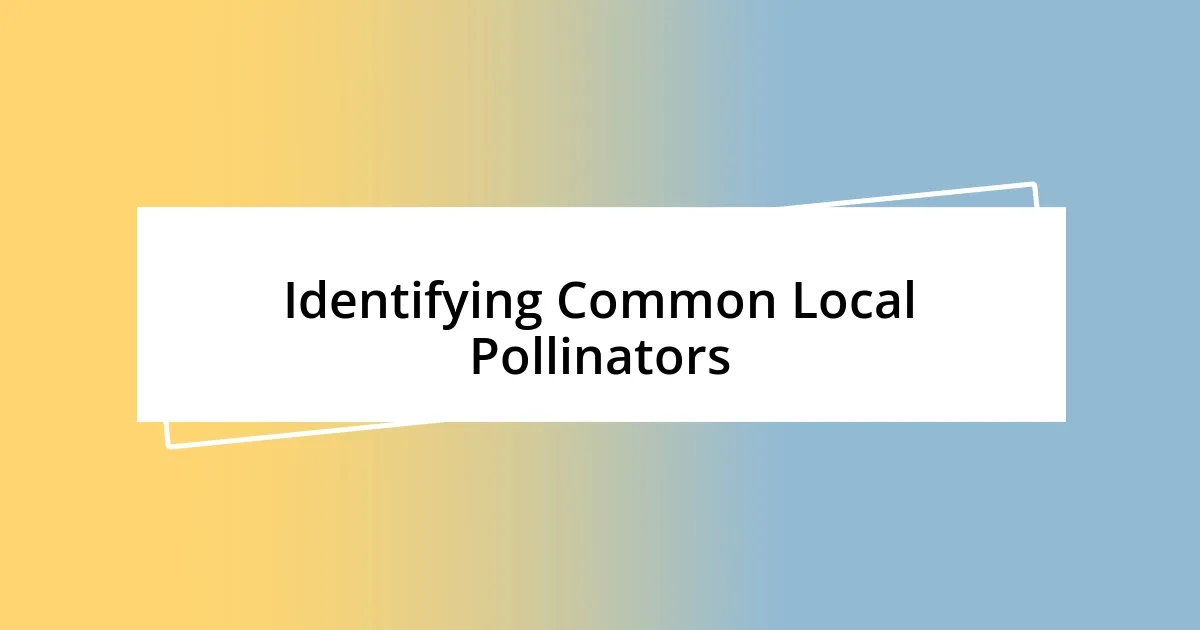
Identifying Common Local Pollinators
Identifying local pollinators can be an enlightening experience, and I can’t help but smile whenever I spot one of these tiny workers in action. One afternoon, while gardening, I noticed a particularly vibrant monarch butterfly hovering over my milkweed. It wasn’t just beautiful; it was a critical pollinator for the plants I had chosen specifically to support the local ecosystem. Identifying these creatures hinges not only on their appearance but also on understanding their behaviors and habitats.
Here are some common local pollinators to look out for:
- Honeybees: Often visible buzzing around colorful flowers, their hives can sometimes be spotted in nearby trees.
- Bumblebees: Larger and rounder than honeybees, they have a distinctive fluffy appearance and love clustering on blooming flowers.
- Butterflies: Their variety in color and patterns is stunning, especially the striking swallowtail or the lovely painted lady.
- Hummingbirds: So agile and quick, these tiny birds dart around nectar-rich blooms, and a feeder is a surefire way to attract them.
- Moths: Often overlooked, nocturnal species like the hummingbird moth are crucial nighttime pollinators, visiting flowers after sunset.
Recognizing these pollinators in your own garden can be highly gratifying. One spring evening, while sitting outside and sipping lemonade, I watched a hummingbird flitting between my fuchsia and salvia plants. It struck me how much better I felt knowing my small efforts were providing sustenance for nature’s nectar lovers. Understanding the unique qualities of each pollinator made me appreciate their contributions even more, and I encourage others to take the time to observe and learn about the vibrant world that exists right outside their doors.
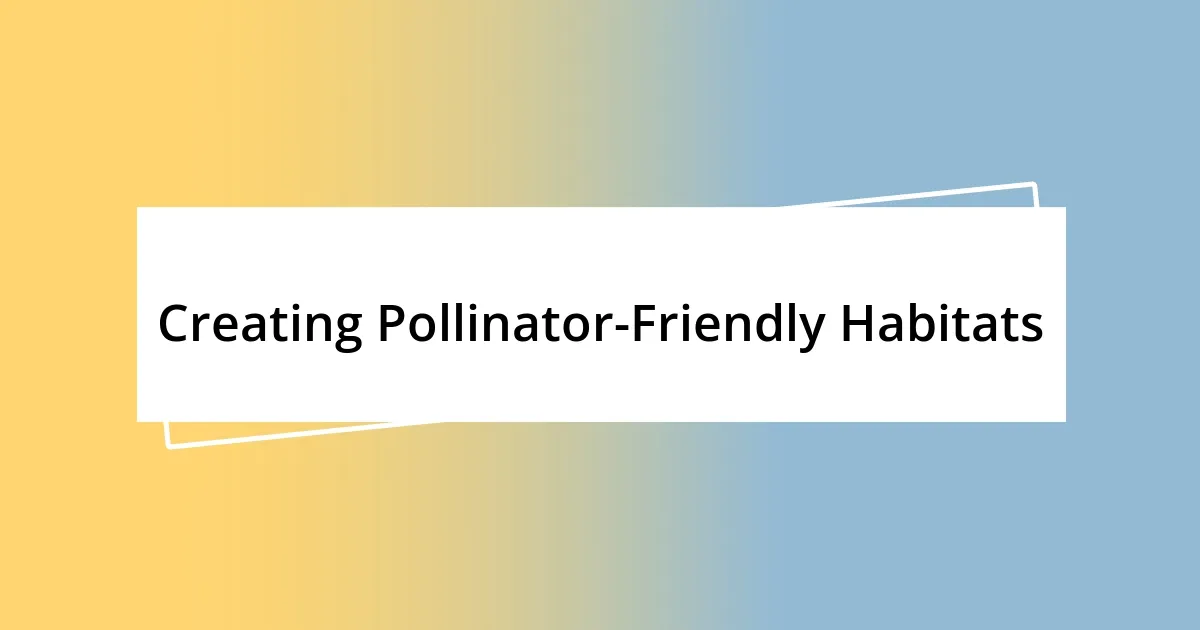
Creating Pollinator-Friendly Habitats
Creating pollinator-friendly habitats is a rewarding journey that often begins in our own backyards. I vividly remember transforming a patch of my garden into a wildflower haven, where my hopes were simple: to attract more butterflies and bees. The delightful surprise came when I noticed not just an increase in the friendly buzz around me, but also the joyful chorus of birds that followed. Isn’t it amazing how one small change can ripple out to benefit entire communities?
In my experience, incorporating native plants is crucial for these habitats. One summer, I swapped out my traditional landscaping for a variety of native species, and the change was nothing short of magical. Suddenly, my garden became a bustling hub, filled with vibrant colors and diverse life. I often found myself just standing there, soaking in the beauty—the way the sun caught a dragonfly’s wings as it danced between the blossoms. It’s incredible how these native plants provide not only nectar but also shelter and breeding grounds for various pollinators, creating a thriving ecosystem right at home.
Water sources are another vital component that many overlook when creating these friendly habitats. I decided to add a small birdbath adorned with stones to allow bees and butterflies to hydrate safely. The joy of seeing a butterfly land for a sip was heartwarming, turning an ordinary day into a moment of connection with nature. Have you thought about how a simple water feature might enhance your space? It’s all about creating an inviting atmosphere where these important little creatures can thrive, reminding us that even the smallest actions can lead to significant impacts in our environment.
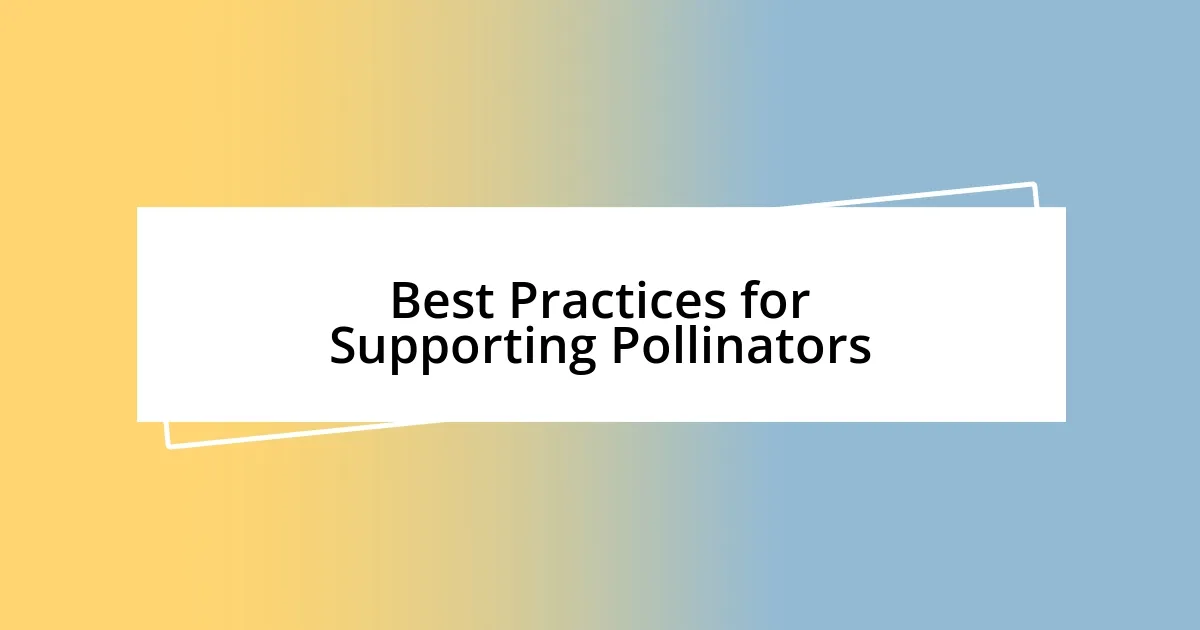
Best Practices for Supporting Pollinators
One of the most effective best practices for supporting pollinators is to plant a variety of flowering plants that bloom throughout the season. I remember last spring when I intentionally chose flowers like echinacea, zinnias, and asters. Not only were they a delight to my eyes, but they also attracted bees and butterflies right to my garden. It felt like hosting a party where I was simply the grateful guest, watching nature’s diversity unfold around me. Have you ever considered how beneficial diverse blooms can be for pollinators?
Another important approach is to minimize or eliminate the use of pesticides and herbicides. I’ve seen firsthand how a single spray can devastate the very creatures we’re trying to support. During one gardening session, I was tempted to reach for bug spray, but remembering the delicate balance of my ecosystem made me pause. Instead, I opted for natural pest solutions, like introducing ladybugs to keep aphids in check. It reminded me that sometimes, nurturing requires us to rethink our habits in favor of the greater good.
Lastly, providing nesting sites can make a world of difference. In my yard, I’ve created small areas with twigs and a brush pile, which inadvertently became a sanctuary for solitary bees. Witnessing these bees diligently go about their business, seemingly thriving thanks to my little effort, filled me with such joy. Have you ever thought about how a small corner of your garden could make a big impact? These nesting sites are often overlooked, but they’re crucial for the life cycle of pollinators. Each small action contributes to the larger narrative of nurturing our pollinator friends.

